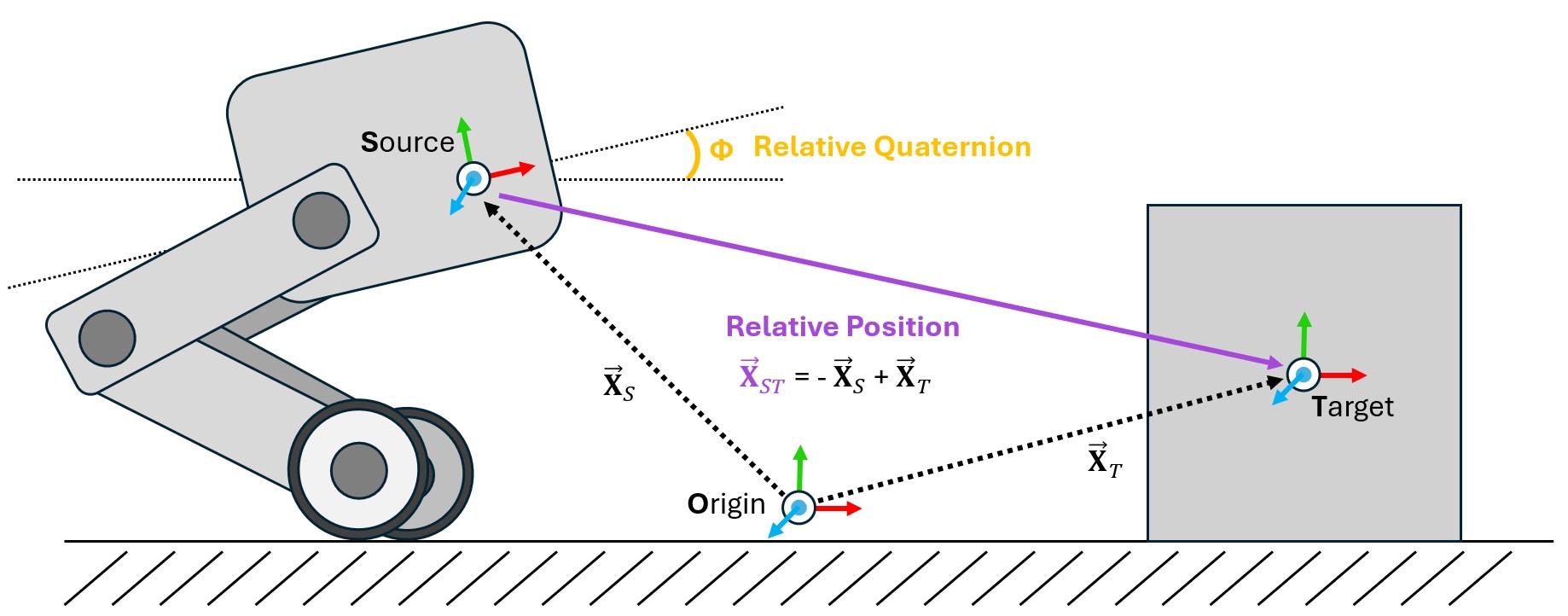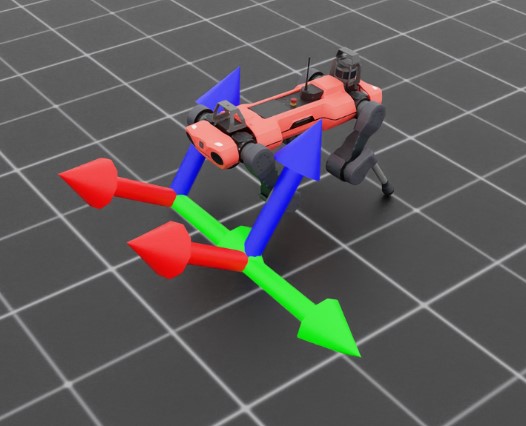Frame Transformer#

One of the most common operations that needs to be performed within a physics simulation is the frame transformation: rewriting a vector or quaternion in the basis of an arbitrary euclidean coordinate system. There are many ways to accomplish this within Isaac and USD, but these methods can be cumbersome to implement within Isaac Lab’s GPU based simulation and cloned environments. To mitigate this problem, we have designed the Frame Transformer Sensor, that tracks and calculate the relative frame transformations for rigid bodies of interest to the scene.
The sensory is minimally defined by a source frame and a list of target frames. These definitions take the form of a prim path (for the source) and list of regex capable prim paths the rigid bodies to be tracked (for the targets).
@configclass
class FrameTransformerSensorSceneCfg(InteractiveSceneCfg):
"""Design the scene with sensors on the robot."""
# ground plane
ground = AssetBaseCfg(prim_path="/World/defaultGroundPlane", spawn=sim_utils.GroundPlaneCfg())
# lights
dome_light = AssetBaseCfg(
prim_path="/World/Light", spawn=sim_utils.DomeLightCfg(intensity=3000.0, color=(0.75, 0.75, 0.75))
)
# robot
robot = ANYMAL_C_CFG.replace(prim_path="{ENV_REGEX_NS}/Robot")
# Rigid Object
cube = RigidObjectCfg(
prim_path="{ENV_REGEX_NS}/Cube",
spawn=sim_utils.CuboidCfg(
size=(1, 1, 1),
rigid_props=sim_utils.RigidBodyPropertiesCfg(),
mass_props=sim_utils.MassPropertiesCfg(mass=100.0),
collision_props=sim_utils.CollisionPropertiesCfg(),
physics_material=sim_utils.RigidBodyMaterialCfg(static_friction=1.0),
visual_material=sim_utils.PreviewSurfaceCfg(diffuse_color=(0.0, 1.0, 0.0), metallic=0.2),
),
init_state=RigidObjectCfg.InitialStateCfg(pos=(5, 0, 0.5)),
)
specific_transforms = FrameTransformerCfg(
prim_path="{ENV_REGEX_NS}/Robot/base",
target_frames=[
FrameTransformerCfg.FrameCfg(prim_path="{ENV_REGEX_NS}/Robot/LF_FOOT"),
FrameTransformerCfg.FrameCfg(prim_path="{ENV_REGEX_NS}/Robot/RF_FOOT"),
],
debug_vis=True,
)
cube_transform = FrameTransformerCfg(
prim_path="{ENV_REGEX_NS}/Robot/base",
target_frames=[FrameTransformerCfg.FrameCfg(prim_path="{ENV_REGEX_NS}/Cube")],
debug_vis=False,
)
robot_transforms = FrameTransformerCfg(
prim_path="{ENV_REGEX_NS}/Robot/base",
target_frames=[FrameTransformerCfg.FrameCfg(prim_path="{ENV_REGEX_NS}/Robot/.*")],
debug_vis=False,
)
We can now run the scene and query the sensor for data
def run_simulator(sim: sim_utils.SimulationContext, scene: InteractiveScene):
.
.
.
# Simulate physics
while simulation_app.is_running():
.
.
.
# print information from the sensors
print("-------------------------------")
print(scene["specific_transforms"])
print("relative transforms:", scene["specific_transforms"].data.target_pos_source)
print("relative orientations:", scene["specific_transforms"].data.target_quat_source)
print("-------------------------------")
print(scene["cube_transform"])
print("relative transform:", scene["cube_transform"].data.target_pos_source)
print("-------------------------------")
print(scene["robot_transforms"])
print("relative transforms:", scene["robot_transforms"].data.target_pos_source)
Let’s take a look at the result for tracking specific objects. First, we can take a look at the data coming from the sensors on the feet
-------------------------------
FrameTransformer @ '/World/envs/env_.*/Robot/base':
tracked body frames: ['base', 'LF_FOOT', 'RF_FOOT']
number of envs: 1
source body frame: base
target frames (count: ['LF_FOOT', 'RF_FOOT']): 2
relative transforms: tensor([[[ 0.4658, 0.3085, -0.4840],
[ 0.4487, -0.2959, -0.4828]]], device='cuda:0')
relative orientations: tensor([[[ 0.9623, 0.0072, -0.2717, -0.0020],
[ 0.9639, 0.0052, -0.2663, -0.0014]]], device='cuda:0')

By activating the visualizer, we can see that the frames of the feet are rotated “upward” slightly. We can also see the explicit relative positions and rotations by querying the sensor for data, which returns these values as a list with the same order as the tracked frames. This becomes even more apparent if we examine the transforms specified by regex.
-------------------------------
FrameTransformer @ '/World/envs/env_.*/Robot/base':
tracked body frames: ['base', 'LF_FOOT', 'LF_HIP', 'LF_SHANK', 'LF_THIGH', 'LH_FOOT', 'LH_HIP', 'LH_SHANK', 'LH_THIGH', 'RF_FOOT', 'RF_HIP', 'RF_SHANK', 'RF_THIGH', 'RH_FOOT', 'RH_HIP', 'RH_SHANK', 'RH_THIGH', 'base']
number of envs: 1
source body frame: base
target frames (count: ['LF_FOOT', 'LF_HIP', 'LF_SHANK', 'LF_THIGH', 'LH_FOOT', 'LH_HIP', 'LH_SHANK', 'LH_THIGH', 'RF_FOOT', 'RF_HIP', 'RF_SHANK', 'RF_THIGH', 'RH_FOOT', 'RH_HIP', 'RH_SHANK', 'RH_THIGH', 'base']): 17
relative transforms: tensor([[[ 4.6581e-01, 3.0846e-01, -4.8398e-01],
[ 2.9990e-01, 1.0400e-01, -1.7062e-09],
[ 2.1409e-01, 2.9177e-01, -2.4214e-01],
[ 3.5980e-01, 1.8780e-01, 1.2608e-03],
[-4.8813e-01, 3.0973e-01, -4.5927e-01],
[-2.9990e-01, 1.0400e-01, 2.7044e-09],
[-2.1495e-01, 2.9264e-01, -2.4198e-01],
[-3.5980e-01, 1.8780e-01, 1.5582e-03],
[ 4.4871e-01, -2.9593e-01, -4.8277e-01],
[ 2.9990e-01, -1.0400e-01, -2.7057e-09],
[ 1.9971e-01, -2.8554e-01, -2.3778e-01],
[ 3.5980e-01, -1.8781e-01, -9.1049e-04],
[-5.0090e-01, -2.9095e-01, -4.5746e-01],
[-2.9990e-01, -1.0400e-01, 6.3592e-09],
[-2.1860e-01, -2.8251e-01, -2.5163e-01],
[-3.5980e-01, -1.8779e-01, -1.8792e-03],
[ 0.0000e+00, 0.0000e+00, 0.0000e+00]]], device='cuda:0')
Here, the sensor is tracking all rigid body children of Robot/base, but this expression is inclusive, meaning that the source body itself is also a target. This can be seen both by examining the source and target list, where base appears twice, and also in the returned data, where the sensor returns the relative transform to itself, (0, 0, 0).
Code for frame_transformer_sensor.py
1# Copyright (c) 2022-2025, The Isaac Lab Project Developers.
2# All rights reserved.
3#
4# SPDX-License-Identifier: BSD-3-Clause
5
6import argparse
7
8from isaaclab.app import AppLauncher
9
10# add argparse arguments
11parser = argparse.ArgumentParser(description="Tutorial on adding sensors on a robot.")
12parser.add_argument("--num_envs", type=int, default=1, help="Number of environments to spawn.")
13# append AppLauncher cli args
14AppLauncher.add_app_launcher_args(parser)
15# parse the arguments
16args_cli = parser.parse_args()
17
18# launch omniverse app
19app_launcher = AppLauncher(args_cli)
20simulation_app = app_launcher.app
21
22"""Rest everything follows."""
23
24import torch
25
26import isaaclab.sim as sim_utils
27from isaaclab.assets import AssetBaseCfg, RigidObjectCfg
28from isaaclab.scene import InteractiveScene, InteractiveSceneCfg
29from isaaclab.sensors import FrameTransformerCfg
30from isaaclab.utils import configclass
31
32##
33# Pre-defined configs
34##
35from isaaclab_assets.robots.anymal import ANYMAL_C_CFG # isort: skip
36
37
38@configclass
39class FrameTransformerSensorSceneCfg(InteractiveSceneCfg):
40 """Design the scene with sensors on the robot."""
41
42 # ground plane
43 ground = AssetBaseCfg(prim_path="/World/defaultGroundPlane", spawn=sim_utils.GroundPlaneCfg())
44
45 # lights
46 dome_light = AssetBaseCfg(
47 prim_path="/World/Light", spawn=sim_utils.DomeLightCfg(intensity=3000.0, color=(0.75, 0.75, 0.75))
48 )
49
50 # robot
51 robot = ANYMAL_C_CFG.replace(prim_path="{ENV_REGEX_NS}/Robot")
52
53 # Rigid Object
54 cube = RigidObjectCfg(
55 prim_path="{ENV_REGEX_NS}/Cube",
56 spawn=sim_utils.CuboidCfg(
57 size=(1, 1, 1),
58 rigid_props=sim_utils.RigidBodyPropertiesCfg(),
59 mass_props=sim_utils.MassPropertiesCfg(mass=100.0),
60 collision_props=sim_utils.CollisionPropertiesCfg(),
61 physics_material=sim_utils.RigidBodyMaterialCfg(static_friction=1.0),
62 visual_material=sim_utils.PreviewSurfaceCfg(diffuse_color=(0.0, 1.0, 0.0), metallic=0.2),
63 ),
64 init_state=RigidObjectCfg.InitialStateCfg(pos=(5, 0, 0.5)),
65 )
66
67 specific_transforms = FrameTransformerCfg(
68 prim_path="{ENV_REGEX_NS}/Robot/base",
69 target_frames=[
70 FrameTransformerCfg.FrameCfg(prim_path="{ENV_REGEX_NS}/Robot/LF_FOOT"),
71 FrameTransformerCfg.FrameCfg(prim_path="{ENV_REGEX_NS}/Robot/RF_FOOT"),
72 ],
73 debug_vis=True,
74 )
75
76 cube_transform = FrameTransformerCfg(
77 prim_path="{ENV_REGEX_NS}/Robot/base",
78 target_frames=[FrameTransformerCfg.FrameCfg(prim_path="{ENV_REGEX_NS}/Cube")],
79 debug_vis=False,
80 )
81
82 robot_transforms = FrameTransformerCfg(
83 prim_path="{ENV_REGEX_NS}/Robot/base",
84 target_frames=[FrameTransformerCfg.FrameCfg(prim_path="{ENV_REGEX_NS}/Robot/.*")],
85 debug_vis=False,
86 )
87
88
89def run_simulator(sim: sim_utils.SimulationContext, scene: InteractiveScene):
90 """Run the simulator."""
91 # Define simulation stepping
92 sim_dt = sim.get_physics_dt()
93 sim_time = 0.0
94 count = 0
95
96 # Simulate physics
97 while simulation_app.is_running():
98
99 if count % 500 == 0:
100 # reset counter
101 count = 0
102 # reset the scene entities
103 # root state
104 # we offset the root state by the origin since the states are written in simulation world frame
105 # if this is not done, then the robots will be spawned at the (0, 0, 0) of the simulation world
106 root_state = scene["robot"].data.default_root_state.clone()
107 root_state[:, :3] += scene.env_origins
108 scene["robot"].write_root_pose_to_sim(root_state[:, :7])
109 scene["robot"].write_root_velocity_to_sim(root_state[:, 7:])
110 # set joint positions with some noise
111 joint_pos, joint_vel = (
112 scene["robot"].data.default_joint_pos.clone(),
113 scene["robot"].data.default_joint_vel.clone(),
114 )
115 joint_pos += torch.rand_like(joint_pos) * 0.1
116 scene["robot"].write_joint_state_to_sim(joint_pos, joint_vel)
117 # clear internal buffers
118 scene.reset()
119 print("[INFO]: Resetting robot state...")
120 # Apply default actions to the robot
121 # -- generate actions/commands
122 targets = scene["robot"].data.default_joint_pos
123 # -- apply action to the robot
124 scene["robot"].set_joint_position_target(targets)
125 # -- write data to sim
126 scene.write_data_to_sim()
127 # perform step
128 sim.step()
129 # update sim-time
130 sim_time += sim_dt
131 count += 1
132 # update buffers
133 scene.update(sim_dt)
134
135 # print information from the sensors
136 print("-------------------------------")
137 print(scene["specific_transforms"])
138 print("relative transforms:", scene["specific_transforms"].data.target_pos_source)
139 print("relative orientations:", scene["specific_transforms"].data.target_quat_source)
140 print("-------------------------------")
141 print(scene["cube_transform"])
142 print("relative transform:", scene["cube_transform"].data.target_pos_source)
143 print("-------------------------------")
144 print(scene["robot_transforms"])
145 print("relative transforms:", scene["robot_transforms"].data.target_pos_source)
146
147
148def main():
149 """Main function."""
150
151 # Initialize the simulation context
152 sim_cfg = sim_utils.SimulationCfg(dt=0.005, device=args_cli.device)
153 sim = sim_utils.SimulationContext(sim_cfg)
154 # Set main camera
155 sim.set_camera_view(eye=[3.5, 3.5, 3.5], target=[0.0, 0.0, 0.0])
156 # design scene
157 scene_cfg = FrameTransformerSensorSceneCfg(num_envs=args_cli.num_envs, env_spacing=2.0)
158 scene = InteractiveScene(scene_cfg)
159 # Play the simulator
160 sim.reset()
161 # Now we are ready!
162 print("[INFO]: Setup complete...")
163 # Run the simulator
164 run_simulator(sim, scene)
165
166
167if __name__ == "__main__":
168 # run the main function
169 main()
170 # close sim app
171 simulation_app.close()

